
australia

Where: Sydney, Katoomba, Blackheath, Narooma, Melbourne, Mallacoota. Australia, Oceania.
When: August 2015
What: Climbing the Sydney Harbour Bridge, Sydney Opera House, Sydney Tower Eye, Stroking a Koala Bear, Kangaroos, Feeding a Wallaby, Seals, Princes Highway, Grand Pacific Drive, Iconic Cell Block H Wall, Melbourne Graffiti, Iconic Wildlife Signage, Blue Mountains, Australia Rock, Wild West Architecture, Channel 10 Studios of Cell Block H fame.
How: Train, international flights, hire car, ferry, bus, taxi.
Country counter: No.68
Mishaps or illnesses: Travel sickness from long car journeys; slipping on a rock at Narooma and landing in a rock pool narrowly avoiding the loss of my camera; bashing my head on of the steel girders of the Sydney Harbour Bridge.
Australia is a truly iconic destination - its buildings, wildlife and even shape are known around the world. It's a land of kangaroos and koalas, Indigenous Australians and the dusty red outback, surfer dudes and spectacularly bad, but nevertheless addictive, television soap operas. Of course, away from these stereotypical images of Oz lies a country as complex as it is vast. It's a country struggling to reconcile its traditional beliefs underpinned by Christianity with the more liberal demands of a modern, cosmopolitan populace in its big cities. Indeed, the debate about whether to legalise gay marriage dominated the headlines during our time in the country. Australia's glitzy cities feel seemingly at odds with the country's First Nation population with racial tensions finding their expression through quiet, dignified protest: "Black houses on black land" declared one giant banner flapping along the walls just outside Sydney Central train station. Indeed, I was watching Australia's morning TV programme Sunrise, with its backdrop out onto Sydney's Martin Place, when an Indigenous man held up a placard declaring "I won't be bullied by racist neighbours or government". The Sunrise cameras did their best to avoid the placard taking centre stage but it is all too obvious. I had seen it. And so, likely, had the million or so Australians watching. Add to this Australia's British colonial hangover, the cultural and economic influence of Asian neighbours such as China, and it's safe to say that you've got a very interesting country ahead of you when you first step onto Australia's scorched brown land. Outwardly, Australia is confident and brash. Inwardly it appears uncomfortable, even troubled.
My journey to Australia marked my 66th country and, touching down on Oceania, also my fifth continent. Going Down Under is the furthest south I have ever travelled and the first time I've crossed the Equator; Australia therefore broke new travel ground for me - literally and metaphorically. Taking three connecting flights to get there, it's also the furthest I have ever travelled to get to a single destination. This was a mini road trip, by Australian standards anyway, along part of the famous Princes Highway and a small part of the picturesque Grand Pacific Drive from Sydney down the coast to Melbourne, stopping overnight along the way in the country towns of Narooma and Mallacoota in a bid to sample Aussie life outside of the state capitals. A foray out to the Blue Mountains region at Blackheath and Katoomba ensured we included a token dip into the famed Aussie bush, too. We were keen not to repeat the mistakes of a similar trip along Canada's eastern coastline by train in 2011 which was exclusively city-based and therefore felt lacking. Once you've seen one city, you've seen them all, right? Our Aussie adventure was therefore deliberately varied: capital cities, coastlines, countryside, bushland and country towns.
sydney
City of world renown and our base for the first four days of our trip was Sydney, in the popular mind the defacto 'capital' of Australia. The actual capital is Canberra - Australia's political and administrative centre and, being thus, no one seems to want to go there - least of all tourists. It's not too dissimilar to other countries which have split their capital cities in two: Turkey's Ankara/Istanbul, Canada's Ottawa/Toronto and, perhaps most notably of all, the USA's Washington DC/New York. It's unlike me to visit a country and not experience its capital but, to use the Aussie vernacular, I don't "give a stuff". Aussies themselves don't seem to care too much about Canberra, so why should I?
Sydney has an oppressive downtown area (Aussies say "CBD" instead of city centre). Its glass towers make you feel like you're locked into a some kind of corporate nightmare but the city's buzzing independent café scene goes a long way to curbing this impersonal corporate excess by adding a much-needed slice of local character. Many serve an awesome latte ("flat white") with equally awesome Aussie friendliness. Note to self: Aussies tend to talk. A lot. In fact, to use current parlance, they 'over share'. It is quite normal to get a chunk of someone's life story wherever you happen to be: browsing in a clothes store, travelling in a lift, standing on a street corner waiting for the pedestrian lights to change. They also tend to insert themselves in to what you had assumed was a private conversation, joining in as if they know you. Never before have I been so reminded of my British reserve and aloofness than in Australia. Some find Aussie frankness rude, others liberating and refreshing. I'd opt for the latter.
Our first morning in Sydney was spent sleeping off the very worst of the jet lag caused by a nine-hour jump forward to Australian Eastern Standard Time (AEST) and a full 24 hours of travelling inside an aluminium tube at 40,000 feet. The afternoon comprised of an impatient walk, fuelled by the kind of nervous excitement only a traveller who has just landed in a new country can appreciate, down to Sydney's famous Harbour with its iconic Harbour Bridge and even more iconic Opera House. A short return ferry ride out to Kirribilli afforded us advantageous views of both. In the back of my mind I couldn't help but brood over the fact that in half a day's time I'd be climbing to the top of one of them...
The Sydney Harbour Bridge is the largest single span arch bridge in the world and was, incongruously, designed by a company in Middlesbrough, United Kingdom. For around £150, and by booking well in advance online, you can climb over the top of the bridge's famous iron arch, known locally as 'the coathanger'. It just so happened to be my birthday, too. Viewing the famous Sydney Opera House and the glittering towers of Sydney's CBD from a unique 360 degree standpoint was a pretty special way to spend my birthday - one spoiled marginally by the forceful whacking of my head on one of its unforgiving steel girders. Unfortunately this would not be the last stupidity-induced injury I was to suffer on this, my first journey Down Under.
I have been to the top of many a world tower - from Lithuania to Canada. I was not about to make an exception for Sydney. An obligatory trip to the top of the woefully-named Sydney Tower Eye completed my suite of stunning photographs of Sydney's skyscrapers and Central Business District. These observation towers are often some of the worst tourist traps going but the views they provide are often well worth the sufferance. Bring your camera and a dose of tourist tolerance. A place in Sydney which also had me running for the exit was Darling Harbour - a waterside location stuffed full of families, chain restaurants and street vendors selling 'I love Sydney' baseball caps. Nothing authentic nor interesting to see here, move along please.
Having sampled both the Harbour Bridge and Opera House, the next was to stroke a Koala Bear - one of Australia's most iconic indigenous, and absolutely wonderful, creatures. Koalas are more protected by government legislation now than at any time in the past and this means the days of holding or hugging one are, quite rightly, passed. We made the long journey out to Sydney's Doonside suburb, home to the Featherdale Wildlife Park. Being a little more off the beaten track meant that the sanctuary sidesteps the worst of the tourist hordes resulting in a more intimate and laid back experience. I was more than satisfied, though, with the chance to stand next to a Koala called Chloe and stroke her coarse, thick fur. She was fast asleep on a branch stuffed full of eucalyptus leaves and took absolutely no notice of me whatsoever. A member of staff was on hand to ensure that each person patting Chloe's furry behind was doing so in exactly the correct manner and that all camera flashes were turned off. Apparently when the bears are fed up of being petted, they simply climb down the trunk and waddle off. Some stay for ten minutes and others, like Chloe, stay for a couple of hours (the government imposes a strict limit of three hours for this kind of thing). The park also allowed me to see other weird and wonderful creatures unique to Australia: Wombats, Quokkas and Echidnas. I ended up feeding a few hungry Wallabies (small Kangaroos) who had taken a liking to the cone of food I was holding. I wasn't to know it at the time but we were to see plenty of Kangaroos out in the wild on our driving tour of the south east coast of the country a couple of days later.
The awesome sails of the iconic Sydney Opera House.
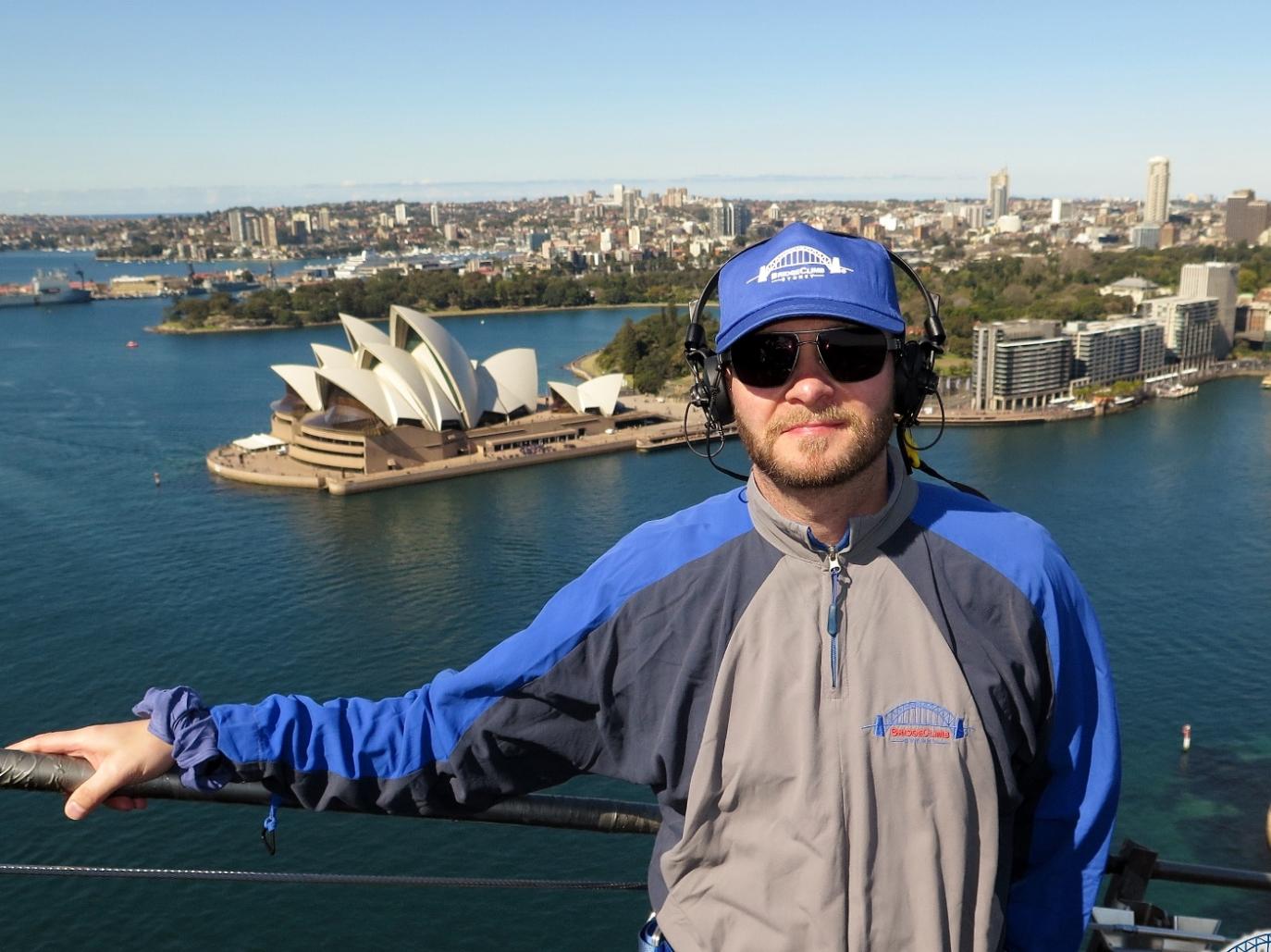
Climbing to the top of the Sydney Harbour Bridge Climb affords wonderful views of the famous harbour.
Sydney's CBD is as close as you'll get to a Manhattan in the Southern Hemisphere.
katoomba & blackheath
Sixty miles west of Sydney, and easily accessible by train from Sydney Central, lies the Blue Mountains region which has some of the grandest and greatest views of bushland going. Vast valleys are covered with eucalyptus gum trees which emit an oily mist giving the mountains a blue hue and thus this region's name. A trip out to the Blue Mountains is a chance to experience one of Australia's most popular bushwalking destinations in easy reach of a major city.
You can book yourself on an expensive tour but to be honest it's no great feat to organise and travel independently for a fraction of the price. A two hour train trip from Sydney Central to Katoomba or Blackheath costs just $9 (that's £4.50) and is in itself a chance to sample train travel in New South Wales as well as travelling the way locals do - infinitely more preferable to being loaded onto a coach with irritating tourists with their selfie sticks and bussed about along characterless motorways. The journey along the Blue Mountain Line, with wonderful place names like "Zig Zag", "Parramatta" and "Bullaburra", is both scenic, suburban and authentic. Head for the front or back carriages to enjoy this part of Australia rolling by in almost complete silence (these being the quiet carriages - no talking allowed!)
The must-see vista of the Blue Mountains is probably Echo Point at Katoomba with its Three Sisters rock formation. Two stops further along the train line from Katoomba, and a place which sidesteps the worst of the tourist traffic, is the town of Blackheath. It's the kind of place which has quirky little cafes, retro reclamation shops with Golliwogs for sale in the window (yes, you read that right) and where locals pass you by but not before they've greeted you with the obligatory, and admittedly cliché, "G'day". Being a little off the beaten path Blackheath retains a local and authentic charm and is the best place to base yourself if you're considering an overnight stay in the Blue Mountains. We stayed the night at the wonderful Glenella Guesthouse, a characteristically Australian building built in Victorian times; it came complete with wooden veranda and corrugated tin roofing - evidently all the rage in this corner of the world. Being high above sea level, and with August slap bang in the middle of the Australian winter, temperatures dropped to near zero. Luckily, the cosy little guesthouse came complete with a log fire and electric blankets - both were very much required. Glenella was also perfectly positioned for a spot of bushwalking along the valley's edge. We opted for the Cliff Top Track - some five kilometres along a dusty path which cuts through dense eucalyptus trees and was characterised by steep ascents, descents and, satisfyingly, awesome lookout points from which to take in the dizzying immensity of an uninterrupted view.
The awesome expanse of eucalyptus is both beautiful and terrifying to behold.
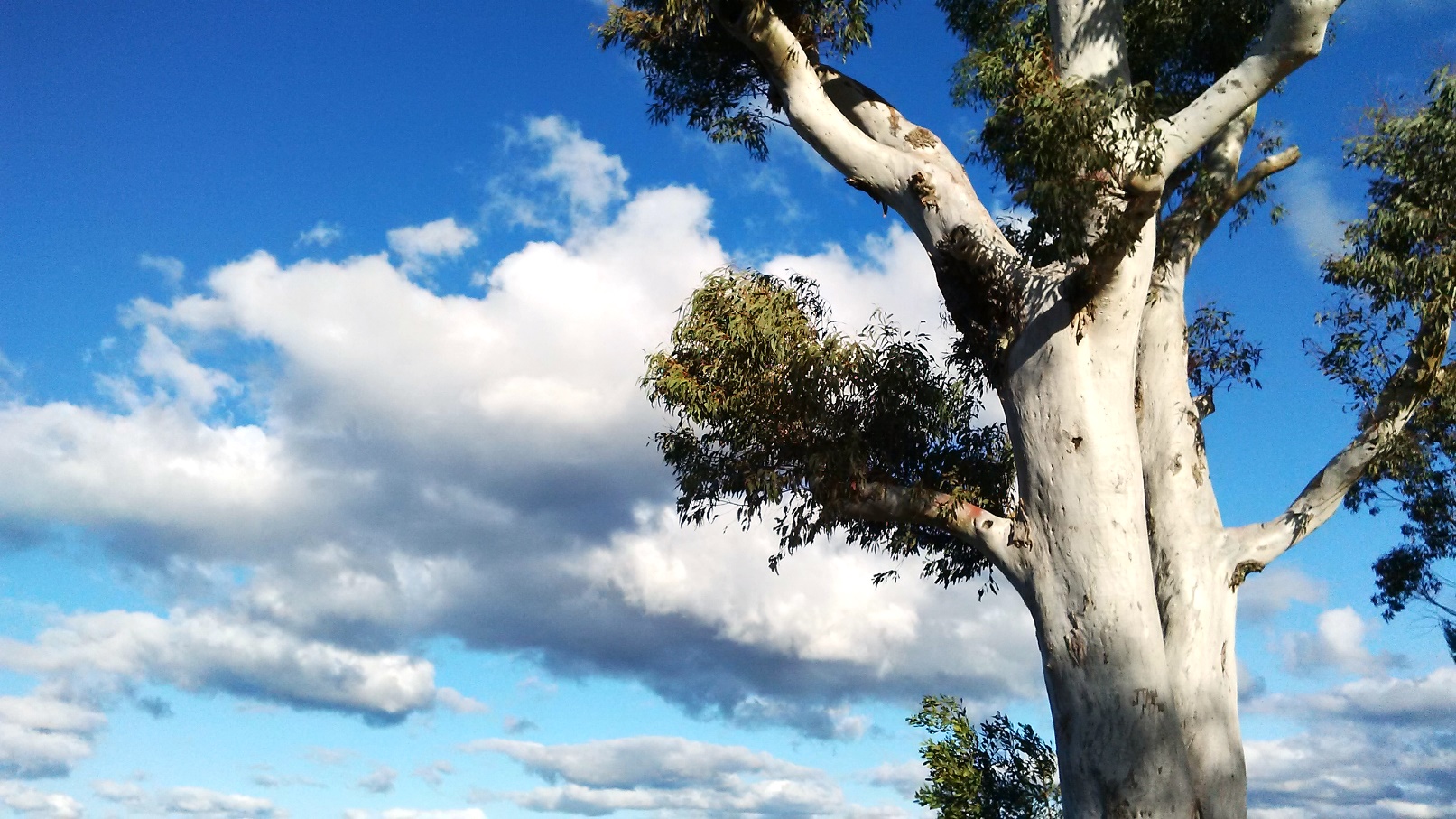
The bulky white trunk of a eucalyptus tree set against blue sky at Blackheath.
The unusual rock formation that is the Three Sisters.
narooma
Narooma is around five hundred kilometres from Sydney: enter stage left our hire car. The journey to Narooma, renowned for its whale watching opportunities, took us along the very scenic Princes Highway and a small chunk of the Great Pacific Road. If the scenery, sudden rises, falls and zig-zags of the road don't keep you interested, the characterful place names like "Bombo", "Jamberoo", "Ullawulla" and "Gerringong" certainly will. Honestly, I am convinced there is not a bland place name in the whole of the country. For added local flavour on your driving trip try listening to the National Indigenous Radio station or you could look out for the iconic yellow diamond signs along the route warning drivers of kangaroos, possums or wombats crossing. Unfortunately any road journey in Australia will inevitably be interspersed with sightings of squashed wombats and kangaroos slumped dead over motorway barriers. The amount of roadkill in Australia is extraordinary and confronting for an animal like me. With an expanse of majestic and magical scenery and mutilated animals, our car driving adventure oscillated between the heavenly and the truly horrific.
Driving meant that we also got to see the curiously incongruous architecture of the south coast's small towns - a number of which became much-needed pit-stops for a coffee and snack. These were places which would look more at home in the American Wild West: wooden panelled shop fronts with corrugated tin roofs and wooden verandas. All that was needed to complete the picture were dusty roads, horses and possibly a couple of cowboys gun slinging at noon. Narooma township had some wonderful examples of this style of architecture, perhaps unsurprising because its existence is intertwined with the late nineteenth century Gold Rush. It could so easily be the setting for an episode of Dr Quinn Medicine Woman.
We set off early the next morning to explore Narooma briefly before crossing the New South Wales border and onto the State capital of Victoria: Melbourne. Having driven for eight hours along the Princes Highway from Sydney, we arrived in a freezing cold Narooma and checked into our motel (my first motel experience). Arriving so late meant that Narooma was pretty much a rest stop along a bigger journey to Melbourne. We'd left it too late to organise a whale watching trip so satisfied ourselves with a walk along the coastline in the hope of seeing another famous Narooma inhabitant: the Grey Seal. Luckily for us a herd of seals had taken to basking in the sunshine opposite Australia Rock, a rock formation whose hole recreates the iconic outline of the country. Unfortunately for me this was where I had accident number two. Wearing completely the wrong gear for scrabbling over wet rocks to get a more crafted photograph of Australia Rock I slipped and landed on my back in one of the jagged rock pools - soaking everything I was wearing and very nearly claiming my non-water resistant camera and mobile phone. Luckily both survived with no water ingress - but only just. My stint as a really poor excuse for a mermaid soon revealed another symptom after the adrenaline had subsided: bruised ribs which made it painful to move and breathe deeply. I took comfort in the thought that it could have been a lot worse. The first aid kit came into its own - not for the first time on this trip. Narooma, and me, were well and truly done.
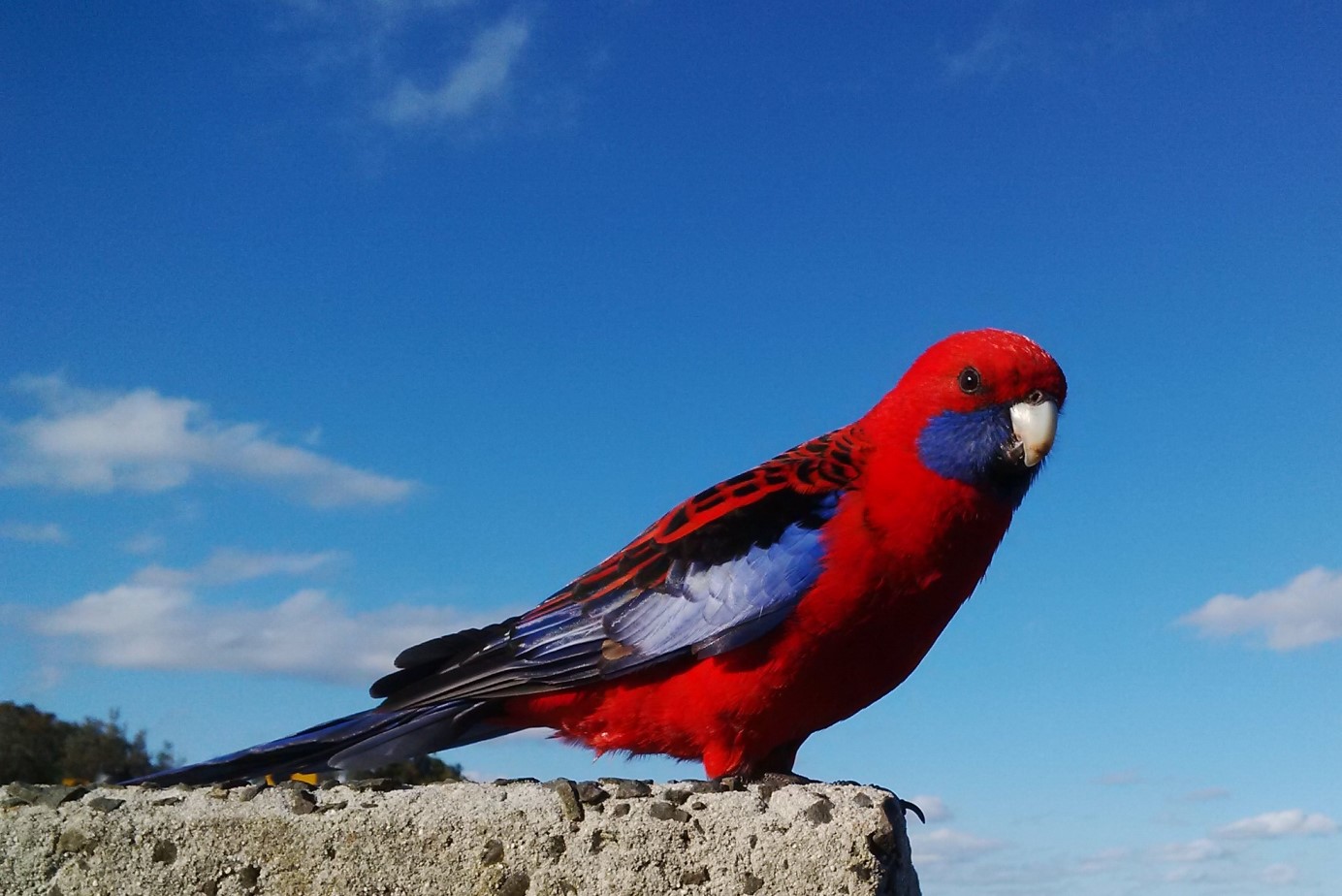
En-route to Narooma: a stop-off at Bald Hill to pick up a coffee from a burger van brings me face to face with a Crimson Rosella parrot. These were a common sight on my trip in south east Australia.
Australia Rock at Narooma beach whose formation mimics the outline of Australia.
A seal enjoys the sunshine along the Narooma coast. And I enjoy the seal.
melbourne
Melbourne is the capital of Victoria - our second, and last, of Australia's capital cities. All signs told us that Melbourne would not be a reprise of Sydney; Melbourne was different. There is a distinct sense of rivalry between the two cities - Sydneysiders stating, a little disparagingly, that Melbourne was "very different" - the word "very" often followed by a raise of the eyebrow or delivered in a somewhat disapproving tone. One friend summed it up succinctly, passing on a well-oiled Melbourne phrase: "If Australia were a body, Sydney would be its heart but Melbourne would be its soul". Sydney has the internationally recognised icons but Melbourne has... well, what exactly? Everyone has heard of Melbourne - but just how many can say what's actually there? I wrestled with my absence of Melbourne knowledge as we entered the city limits.
Whereas Sydney is corporate, mainstream and touristy, Melbourne is alternative, creative and edgy - although your initial impression of the city may mistakenly be formed on its CBD and shopping arcades. A walk along the Yarra River with its token skyscrapers, glass-fronted restaurants and joggers in Lycra is all pretty soulless stuff and characteristic of most modern cities these days. However, Melbourne is one of those places which insists you work that little bit harder to get to the real heart - or should that be soul? The city's laneways are a good place to start - grungy alleyways and backstreets where small, independent bistros, coffee shops and eateries are crammed, so much so they appear to ooze out from their apertures and onto the tiled lanes themselves. Many laneways are a destination in themselves, having become one giant graffiti canvas where artists have run riot with colour and texture. We tracked down the most famous: Hosier Street. I have seen graffiti before, but never in such three dimensional density. Walls, doors and windows are covered from top to bottom. Even the bins have reluctantly become absorbed in to the artwork.
Whereas Sydney is about the CBD, Melbourne is about its suburbs - small, trendy areas with independent bars and restaurants like the area of Collingwood. These kinds of places are where 'real Melbournians' spend their time and are the best place to head if you wish to go beyond surface city sightseeing. We went to a small restaurant on Gertrude Street run by an Aussie couple reminiscent of Jack and Vera from the British soap Coronation Street. Vera's favourite word was "darl" (darling) and we swapped stories with Jack about television soap operas. The food was nothing to write home about, but the warm conversation more than made up for it.
Melbourne's modern architecture, like wavy apartment buildings, multi-coloured abstract fascias (most notably that of the RMIT building) and cubist carbuncles (like that of seen in Federation Square), tries to emulate, or at least reflect, the city's alternative disposition. Some of these buildings would not be out of place in an optical illusion whilst others border on surrealism. Half the time I wondered if my flat white had been interfered with. Melbourne is a far more interesting place to photograph than Sydney. Interestingly, its playful architecture is juxtaposed with Victorian era buildings which help anchor the city's architectural extravagance and give it, at least, some depth.
The soap opera Neighbours has been produced in a Melbourne suburb since its inception. We were considering going on the official Neighbours tour but, realising I actually haven't watched it in years and won't know what it was I would be photographing, we decided to give it a miss. However, from this I discovered that a soap I had watched avidly as a teenager, Prisoner: Cell Block H, was also made in the city. Further digging around online revealed that the iconic red brick wall, which featured in every episode as the exterior of the jail, was still there - and had, more than three decades later, retained many of its fake windows and bars. So, a trip out to Nunawading some 30 kilometres outside of Melbourne by train and then taxi, brought me face to face with the wall I had seen so many times on my television set. I had to intrude upon the residents of a private housing estate, squeeze through bushes and press my camera against the perimeter fence of the former Channel 10 studios to catch a glimpse. A chat with the security guard at the entrance to the now-named Nunawading Studios, and by putting on my best personable performance, yielded no closer access. In typical Aussie bluntness he said he didn't give "a rat's arse" about me going in there to take photos of a building, but said his hands were tied and he wasn't allowed to let us in. Never mind. I was more than satisfied with what I'd seen. A very niche day trip out, certainly, but a brilliant one too.

A rather flattering shot of Melbourne's rather carbuncular Federation Square. Nice to photograph but probably not nice to have to see every day.
A rather wonderful mosaic sculpture along the banks of the River Yarra.
A winter's scene along the River Yarra.

The graffiti canvas that is Melbourne's Hosier Street.
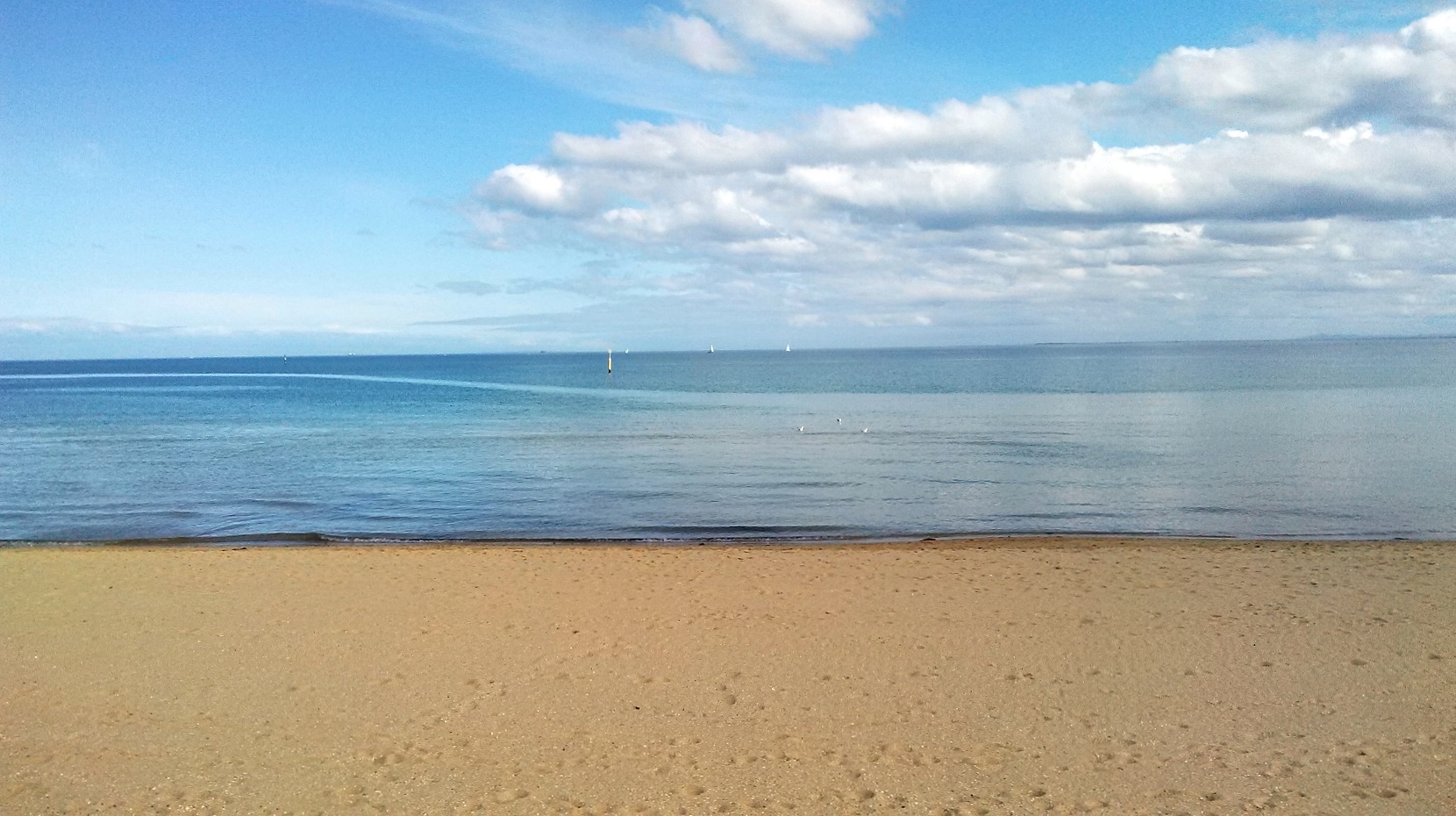
St Kilda beach layers: sand, sea and sky.
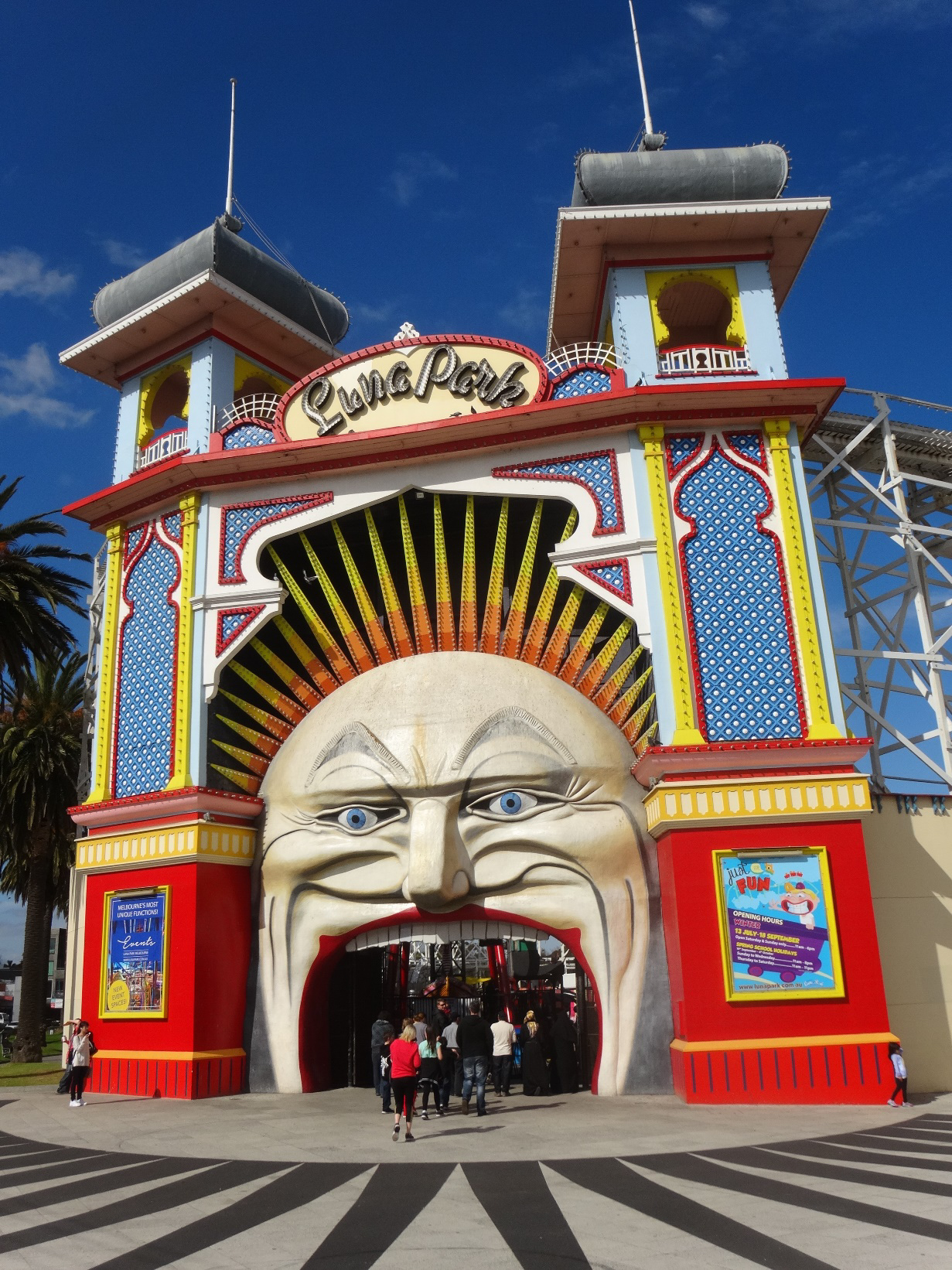
St Kilda Luna Park fairground.
mallacoota
Mallacoota was on our itinerary because it fell roughly half-way between Melbourne and Sydney - an overnight stop along the south coast to break up what would otherwise have been an unmanageable fourteen hour drive. Our arrival in Mallacoota reads like the opening of a classic horror story... We arrived at dusk, two tired and weary travellers in a hire car from the big city. Access to the lodge came from driving along roads with thick woodland encroaching from either side with hazardous hairpin bends. Every other car we see is heading in the opposite direction to us. Do they know something we don't? Pulling into the gravel car park it becomes ominously obvious that we are the only guests staying at this Victorian guesthouse tonight. Walking up the steps of the wooden veranda and into an unlocked lodge we find a note. The owner is not here either. He'll be back soon. "Make yourselves at home, you are in room #1" the note read. The episode rekindled my reading of Stoker's Dracula many years previous... Famished from an eight hour drive we headed into the centre of Mallacoota. Nobody to be seen here, either. Where is everybody? A smell of wintry smoke filled the air...
Our only evening in Mallacoota was spent catching a few shots of the lakeside view, passing a mob of giant kangaroos, and then heading into the main town (population: 900) for a meal at the local hotel which was as old-fashioned as they come: outdated and yellowing sports photographs of the local team hung on the wall, dusty animal heads from past hunting successes joined them and... thankfully the food was delicious! A log fire greeted us on return to the lodge, as did, thankfully the owner who gave us the keys to his house and promptly buggered off. This was an example of the kind of trust and openness you will experience from Aussies. They even have a special word for it: "mateship". A small heater and electric blankets worked hard to keep the cold out of our little cabin, taking us swiftly in to morning - and the most Aussie dawn chorus imaginable. I was not surprised to discover, after experiencing daybreak in this small coastal country town, that Australia has the loudest birds in the world.
Mallacoota Inlet seen from our guesthouse porch. The birdsong in the morning was magical. And deafening.
travel tips, links & resources
- Unless you're a New Zealand citizen you'll need a visa to get into Australia. If you're a British citizen residing in the United Kingdom, you'll also need a visa - but it's free and quick to get one. All completely online, getting an Australian visa has got to be the easiest visa I have ever had the pleasure of acquiring. It came through within thirty minutes of setting up an 'Immi' account.
- There's a lot to be said for flying between Melbourne and Sydney - but make sure you find time to sample life outside of the big cities for a slice of Australia off the beaten track - this is where authentic experiences can be had.
- Road tripping is a quintessentially Australian pastime. Aside from flying, it is really the only practicable way of travelling around this giant scorched land (what's that, you say, no train link between Sydney and Melbourne?) Incorporating a road trip element not only affords you a more grass roots experience, but you also have a chance of spotting the curiously large objects along roadsides, called 'Big Things'. Expect to see anything from giant bananas, to guitars, rocking horses and a crocodile wearing boxing gloves. It's a glimpse into the irreverent humour of the Aussies and part of the culture which has developed around long road trips.
- There's a nasty practise of hotels charging you 2% for using your credit card to pay for your stay. Check before booking or get stung with a hefty hidden extra.
- Contrary to what you may expect, public transport in NSW and Victoria is very cheap. Each state uses its own London-style Oyster card system which links most forms of transport. NSW has the Opal card, Victoria has the Myki card.
you may also like
